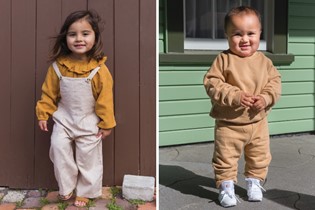Baby sleep: self settling & resettling

Babies love to be held close. So think of yourself as your baby’s buffer; your presence confirms that their world is safe and they’re secure, which in turn helps your baby to build their sense of trust and confidence. This is the hallmark of nurturing — and it’s not spoiling or indulging. It’s about laying a foundation that will support your baby to learn healthy sleep habits and, in time, master the skill of falling asleep unaided.
What is self-settling?
Self-settling is a process which lays the foundation for babies to learn how to fall asleep independently, without the use of aids or props, and with intervention from you only when needed. Although it can be hard to listen to, it is healthy and normal for a baby to cry a little before falling asleep.
Terms of self-settling
Self-settling is often referred to as ‘spaced soothing’ (meaning the spaces of time between interventions): pick up and put down, in and out of the room, and so on. The way I like to define self-settling is that it’s about ‘being’ (touching or engulfing your baby) rather than ‘doing’ (cupping and shushing). In other words, ‘being’ is about being physically present for your baby by either engulfing in them your arms or their cot and being still, and ‘doing’ is about being physically present but also cupping and shushing.
Before starting the journey to help older babies learn the art of self-settling, it’s important to understand that you are endeavouring to change lifetime habits and that it will take time. It is therefore important to look at what is happening in their wake cycles before starting to show your little one how to self-settle. The things that I usually consider here are:
The length of wake cycles in relation to their age — some older babies have short wake cycles, as their sleep cues can in fact be hunger signs, which are often misinterpreted as tired signs.
How often are you feeding your baby in each wake cycle? Trying to get older babies to self-soothe can be difficult when they’re both hungry and tired at the same time.
What types of foods are you feeding your baby? Some foods can affect the sleep of babies who have
digestive issues.
For night-wakers, I always consider their daytime routine to see what’s happening. By sorting out their daytime routine we can often get the baby to sleep well at night.
Where to self-settle
✔ In your arms.
✔ In the cot.
✔ A mixture of the two.
✔ For older babies, lying next to an adult. This can be on the bed if you have one in your little one’s room, or on a bed elsewhere in your home. If your little one’s room is too small to house an additional bed, then I suggest lying on the floor with them. (I have been known to do this). Then, when ready, you can transfer your little one back to their cot.
Whichever method you choose, remember it’s about what works for you, your little one and your family.
Appropriate time and appropriate noise
The length of time you let your baby cry for before intervening is very much governed by instinct and what you and your partner are comfortable with. It’s also dependent on your baby’s age, but above all, it’s critical your little one feels secure at all times and knows that you’re close by to reassure and help them self-settle, rather than being left on their own in their cot for extended periods of time.
Interpreting cries and knowing when to act
A grizzle — I am happy to leave a baby who is grizzling, but you need to decide whether you’re happy to leave this cry.
A cry that is off and on again — I am happy to leave, as long as the cry is more off than on. I also take into account the length of time and the age of the little one.
A cry that reaches an unacceptable peak or is constant — I am not happy to leave this baby alone.
An older baby who screams immediately after I leave the room — I would go back in. If they stop shortly after I leave the room, as is often the case, then it is quite okay not to go back in.
Remember, it takes about 20 minutes for a baby to find their sleep, so if the noise is acceptable (not constant or reaching an unacceptable peak for your baby’s age) then:
❧ It’s okay to step back.
❧ It’s also okay to be in the room when they’re settling.
❧ It’s okay to have hands on your little one while settling them.
❧ It’s okay to pick up your little one and ‘engulf ’ them or lie next to them.
Older babies may cry on and off for up to 20 minutes before finding their sleep. Remember, ideally you will not leave your little one if it is a full-on, constant cry. Reassurance is so important when self-settling.
Remember, it is about appropriate time and appropriate noise. Therefore, you always need to STOP, LISTEN and ACT and respond accordingly to the type of cry it is. Ask yourself when you hear them cry, ‘What are they trying to tell me?’ Would you, for example, ignore a little one who was banging and screaming at the bedroom door?
A reminder of what self-settling is not!
Self-settling is not extinction crying (letting them cry it out). Self-settling is not when you’re doing all the steps to get your baby to sleep, such as large movements, nor is it about ‘plugging’ with a pacifier or dummy, or feeding your baby to sleep. These steps are parent-led methods where you are doing all the ‘doing’ and your baby is doing all the ‘being’.
More often than not these parent-led steps do not work so well, or at least they take longer to work as your baby approaches 16 weeks, which is when they have their first big progressive developmental milestone. If you’re happy doing all or any of these steps to get your baby to sleep until they’re old enough for you to just lie with them until they go to sleep, then it’s okay, but some parents find this way of parenting too hard to carry on through the years, and the older the baby is, the harder it is to change their habits.

What is resettling?
Resettling is about having the ability to link your baby’s sleep cycles together — or, in simpler terms, keeping them asleep. Often babies begin waking up after just a short nap or sleep, which is only one sleep cycle — commonly 30–45 minutes. This is often described as ‘catnapping’. It’s much better for your baby to sleep longer to ensure they get restorative sleep and can continue to sleep through the night as they go through their developmental milestones.
Resettling requires remaining in the room and working with your baby until they lapse into deep sleep. In other words, it’s not just about pacifying them and leaving the room.
You may have to continue resettling for 45 minutes, after which you step back and your baby may continue to sleep on, or they may wake naturally. Resettling is often overlooked, yet it plays a vital role in helping your little one to connect sleep cycles throughout the night. The sooner you gently start showing them the basics, the easier resettling becomes.
Some babies will learn to resettle more easily during their daytime naps while others resettle more quickly at night; and more than likely there will always be one nap cycle where your baby is more difficult to resettle than the others. For older babies, it may take about 45 minutes, although once again all babies are different and some may take more time to resettle than others.
It takes tactThe act of resettling your baby can be demanding! It takes TACT — time, acceptance, consistency (80%) and touch (presence) — along with practise, repetition and commitment from both you and your baby, but believe me, it’s well worth it in the end! |
Do we have to teach baby to resettle?
As with most things in life, the effort you put in will reap rewards. By learning how to resettle themselves, your baby will be well rested and able to resettle overnight with little or no intervention from you, while also having the skills to respond well to any changes or disruption in their daily routine. You will find it a great tool to have on board if your baby is on the move with their older siblings or if you’re planning on travelling, as they’ll be able to be transferred from cot to car to buggy with minimal fuss.
When will my baby sleep through the night?
There’s no easy answer to that question, but your little one’s ability to resettle is a central factor. Once a baby has regained their birth weight, and, as long as there are no medical issues, I try to resettle before feeding — for the younger babies this may be just a few minutes and for the older babies around 45 minutes. Quite often your little one will simply wake overnight for reassurance and not hunger, but you may misread the signs and feed before assessing the situation.
If you take the time to resettle your baby before feeding, it helps ensure that night feeds are for hunger as opposed to comfort. Hungry babies cannot be resettled overnight, so if they’re still not happy then they’re telling you that they need feeding.
If you have an older baby who wakes perhaps from habit, then bed-sharing is an option. If choosing this option, then always try to start the night off by settling your little one in their cot and only transfer to your bed when you feel ready to do so.
If, on the other hand, your little one self-settles and resettles during their daytime naps with little or no intervention from you, but constantly wakes overnight and is inconsolable, then it’s important to listen. They’re trying to tell you something, and it’s up to you to work it out; perhaps they’re refluxing or there may be another underlying medical condition.
The difference between daytime and overnight resettling
For daytime resettling, it’s important in the beginning to start resettling before your baby wakes. For night-time resettling, it’s about allowing them to make their little noises and only intervening when they are clearly calling for your attention.
❧ Daytime resettling
Resettling is all about timing. Regard-less of your baby’s age, for daytime resettling respond to your baby as soon as they show signs of stirring. It’s far easier to resettle a drowsy baby than one who is wide awake.
Over time, you’ll start to take small steps back and wait to see if they can resettle on their own. When you’re ready to step back, my suggestion for daytime naps is that if your baby wakes and they’re happy chatting or playing, leave them in their cots for a short time until they call you.
The aim of resettling is to ensure your baby sleeps for more than one sleep cycle, that is, for a minimum of 1¼ to 1½ hours. If you teach a baby to resettle during the day you will find that, as they grow, they will start to connect their sleep cycles overnight.
❧ Overnight resettling
When resettling overnight it’s important to step back and allow your baby to try to do it themselves without any intervention from you – especially if you’ve been working on daytime resettling. So, instead of responding immediately when your baby stirs (like you do during the day in the beginning), you wait until your baby definitely needs your help to resettle. Stepping back may make overnight resettling more difficult, but it is essential that you give your little one the opportunity to learn how to do it. Once you go to your baby overnight, spend some time resettling them before feeding, as once your baby has been reassured they may go back to sleep again without needing to feed.
Remember, there’s no right or wrong way to parent and ‘parenting to sleep’ is just one part of your journey.
Happy sleeping!

For a comprehensive guide on techniques used in teaching baby to self-settle and re-settle, grab a copy of Dorothy’s book: Simply Parenting: From 12 weeks to 12 months, RRP$40, Bateman Publishing.

AS FEATURED IN ISSUE 51 OF OHbaby! MAGAZINE. CHECK OUT OTHER ARTICLES IN THIS ISSUE BELOW

















